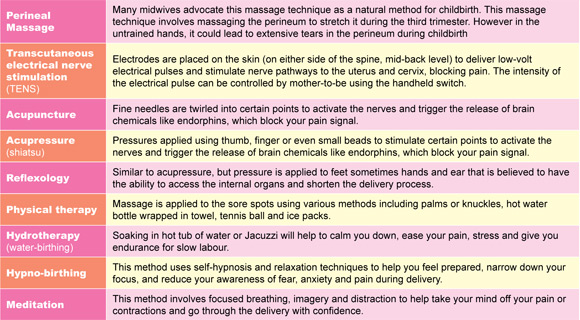The pain of delivery/labour is one worry that all expectant mothers have during the course of their pregnancy. There are many methods that can be used to ease the delivery process – be it the natural way or with pain inhibitors.
Pain relief naturally
If you prefer delivery to be as natural and as comfortable as possible, you may want to consider some form of complementary and alternative medicine. Some physicians may recommend the use of “natural” childbirth techniques as a relaxation aid and as an alternative to pain inhibitors.
If you don’t want to use anaesthetics or drugs to inhibit the pain, there are various options available; you will need to verify their availability before opting for them. Some of the alternative methods available include:
The benefits of going natural are they have low risk, offer great pain relief and relaxing effect to help you manage the labour pain. However, the effects of some of these techniques are not well-understood and require trained practitioners to perform (acupuncture, acupressure and reflexology).
Pain relief with medicines
Apart from the natural techniques, you can also opt for pain relief using medicine. It includes analgesics or tranquilisers that are commonly given if you opt for no anaesthesia. These drugs would not interfere with your contraction, but you may feel drowsy or nauseated, and it may affect the baby’s heart rate and activity soon after birth. Some common analgesics/tranquilisers are:
Nitrous oxide is a selfadministrable inhalation (odourless gas) analgesia that alters your pain perception. It does not eliminate pain and may cause you dizziness, restlessness and nausea.
Opioids/Narcotics can be used to lessen your pain during delivery by altering pain perception and promoting relaxation. Opioids may cause drowsiness, nausea and temporary breathing depression in you and baby.
Some commonly used anaesthetics include:
- Epidural block and spinal block offers complete pain relief in the lower body. It is widely used as it does not slow the delivery process and has little or no side effect on baby. However it may cause imbalance effect on both sides of the body, decrease your blood pressure and baby’s heart rate, blocks bladder emptying during the effective period and may cause breathing difficulties if it affects your chest wall.
- Local anaesthetic injection gives little or no negative effects on you and your baby but it does not relieve the contraction pains. It may also cause allergic reaction.
- Pudendal blocks help relieve pain in the lower vagina and perineum (anus). However the medication may cause allergic reaction or in some cases may only work partially at one side of the perineum.
Whatever your choices are, talk to your health care provider to get professional opinion on your preferred pain management options to prepare and educate yourself on the availability, effectiveness and safety of using the techniques or medications.




Comments